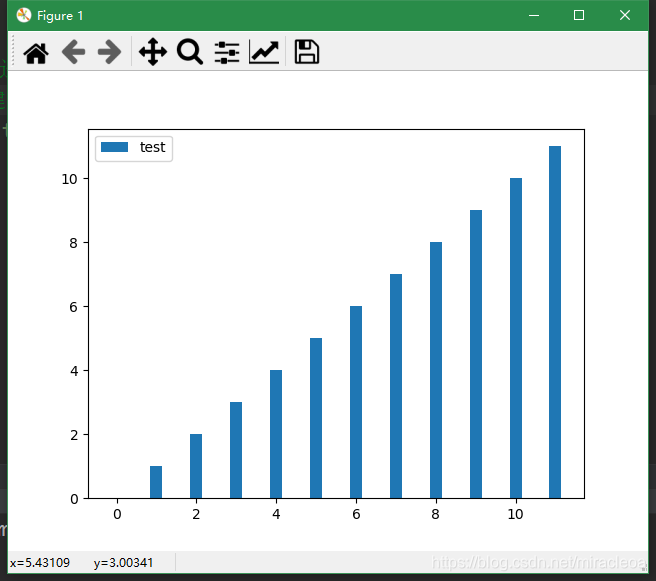【Matplotlib】matplotlib.animation.FuncAnimation绘制动态图、交互式绘图汇总(附官方文档)
文章目录一、以sin举例,motplotlib绘制动图1、绘制sin函数2、动态画出sin函数曲线3、点在曲线上运动4、点,坐标运动二、单摆例子三、滚动的球的例子四、动态条形图五、动态折线图六、交互式绘图七、交互式绘图、混淆矩阵可视化参考一、以sin举例,motplotlib绘制动图1、绘制sin函数import numpy as npimport matplotlibimport matplot
·
文章目录
零、文中用到的相关知识:
- matplotlib官方文档
- matplotlib官方文档(推荐)
- matplotlib.pyplot.plot
- matplotlib.pyplot.tight_layout
- matplotlib.pyplot.text
- matplotlib.animation.FuncAnimation
- matplotlib.animation.Animation.save
- python带括号(实例化)和不带括号(赋值)的区别
matplotlib.pyplot.plot()参数详解
- 函数FuncAnimation
函数FuncAnimation(fig,func,frames,init_func,interval,blit)是绘制动图的主要函数,其参数如下:
a.fig 绘制动图的画布名称`
b.func自定义动画函数,即下边程序定义的函数update
c.frames动画长度,一次循环包含的帧数,在函数运行时,其值会传递给函数update(n)的形参“n”
d.init_func自定义开始帧,即传入刚定义的函数init,初始化函数
e.interval更新频率,以ms计
f.blit选择更新所有点,还是仅更新产生变化的点。应选择True,但mac用户请选择False,否则无法显
- plt画布调整函数
# 调整画布里图像的位置
plt.subplots_adjust(top=0.88,
bottom=0.11,
left=0.11,
right=0.9,
hspace=0.2,
wspace=0.2)
# 使图像在画布上尽可能大,贴着画布边缘
plt.tight_layout()
# 设置画布尺寸
plt.figure(figsize=(11, 5.6))
说在前面,本文介绍了matplotlib两种绘图方式
- plot.pause
- animation
一、以sin举例,motplotlib绘制动图
1、绘制sin函数
# # 在绘制动画前,我们需将其sin函数的背景绘制出来。
x = np.linspace(0, 2 * np.pi, 100)
y = np.sin(x)
# tight_layout 调整子图之间及其周围的填充。
fig = plt.figure(tight_layout=True)
plt.plot(x, y)
plt.grid(ls="--")
plt.savefig("sin_test1.png")
plt.show()

2、动态画出sin函数曲线
# 动态画出sin函数曲线
import numpy as np
import matplotlib.pyplot as plt
from matplotlib.animation import FuncAnimation
# 生成子图,相当于fig = plt.figure(),ax = fig.add_subplot(),其中ax的函数参数表示把当前画布进行分割,
fig, ax = plt.subplots()
xdata, ydata = [], []
ln, = ax.plot([], [], 'r-', animated=False)
def init():
ax.set_xlim(0, 2 * np.pi)
ax.set_ylim(-1, 1)
# 返回曲线
return ln,
def update(frame):
# 将每次传过来的n追加到xdata中
xdata.append(frame)
ydata.append(np.sin(frame))
# 重新设置曲线的值
ln.set_data(xdata, ydata)
return ln,
'''
函数FuncAnimation(fig,func,frames,init_func,interval,blit)是绘制动图的主要函数,其参数如下:
a.fig 绘制动图的画布名称
b.func自定义动画函数,即下边程序定义的函数update
c.frames动画长度,一次循环包含的帧数,在函数运行时,其值会传递给函数update(n)的形参“n”
d.init_func自定义开始帧,即传入刚定义的函数init,初始化函数
e.interval更新频率,以ms计
f.blit选择更新所有点,还是仅更新产生变化的点。应选择True,但mac用户请选择False,否则无法显
'''
ani = FuncAnimation(fig=fig, func=update, frames=np.linspace(0, 2 * np.pi, 128),
init_func=init, blit=True)
plt.show()
ani.save('sin_test1.gif', writer='imagemagick', fps=100)

3、点在曲线上运动
import numpy as np
import matplotlib
import matplotlib.pyplot as plt
import matplotlib.animation as animation
# 首先定义了一个update_points函数,用于更新绘制的图中的数据点。此函数的输入参数num代表当前动画的第几帧,
# 函数的返回,即为我们需要更新的对象,需要特别注意的是:reuturn point_ani,这个逗号一定加上,否则动画不能
# 正常显示。当然这里面操作的点对象point_ani我们一般会提前声明得到:point_ani, = plt.plot(x[0], y[0], "ro")。
# 接下来就是将此函数传入我们的FuncAnimation函数中,函数的参数说明可以参见官网,这里简要说明用到的几个参数。
# 第1个参数fig:即为我们的绘图对象.
# 第2个参数update_points:更新动画的函数.
# 第3个参数np.arrange(0, 100):动画帧数,这需要是一个可迭代的对象。
# interval参数:动画的时间间隔。
# blit参数:是否开启某种动画的渲染。
def update_points(num):
'''
更新数据点
'''
point_ani.set_data(x[num], y[num])
return point_ani,
x = np.linspace(0, 2 * np.pi, 100)
y = np.sin(x)
fig = plt.figure(tight_layout=True)
plt.plot(x, y)
point_ani, = plt.plot(x[0], y[0], "ro")
plt.grid(ls="--")
# 开始制作动画
ani = animation.FuncAnimation(fig, update_points, np.arange(0, 100), interval=100, blit=True)
ani.save('sin_test2.gif', writer='imagemagick', fps=10)
plt.show()

4、点,坐标运动
import numpy as np
import matplotlib
import matplotlib.pyplot as plt
import matplotlib.animation as animation
# 我们可以往其中添加一些文本显示,或者在不同的条件下改变点样式。这其实也非常简单,
# 只需在update_points函数中添加一些额外的,你想要的效果代码即可。
# 我在上面update_points函数中添加了一个文本,让它显示点的(x, y)的坐标值,
# 同时在不同的帧,改变了点的形状,让它在5的倍数帧显示为五角星形状。
# def update_points(num):
# if num % 5 == 0:
# point_ani.set_marker("*")
# point_ani.set_markersize(12)
# else:
# point_ani.set_marker("o")
# point_ani.set_markersize(8)
#
# point_ani.set_data(x[num], y[num])
# text_pt.set_text("x=%.3f, y=%.3f" % (x[num], y[num]))
# return point_ani, text_pt,
# 再稍微改变一下,可以让文本跟着点动。只需将上面的代码update_points函数改为如下代码,其效果如图2-4所示。
def update_points(num):
point_ani.set_data(x[num], y[num])
if num % 5 == 0:
point_ani.set_marker("*")
point_ani.set_markersize(12)
else:
point_ani.set_marker("o")
point_ani.set_markersize(8)
text_pt.set_position((x[num], y[num]))
text_pt.set_text("x=%.3f, y=%.3f" % (x[num], y[num]))
return point_ani, text_pt,
x = np.linspace(0, 2 * np.pi, 100)
y = np.sin(x)
fig = plt.figure(tight_layout=True)
plt.plot(x, y)
point_ani, = plt.plot(x[0], y[0], "ro")
plt.grid(ls="--")
text_pt = plt.text(4, 0.8, '', fontsize=16)
ani = animation.FuncAnimation(fig, update_points, np.arange(0, 100), interval=100, blit=True)
ani.save('sin_test3.gif', writer='imagemagick', fps=10)
plt.show()
-
(1)上述代码,第一个函数

-
(2)上述代码,第二个函数

二、单摆例子
1、scipy中odeint函数用法
- odeint()函数是scipy库中一个数值求解微分方程的函数
- odeint()函数需要至少三个变量,第一个是微分方程函数,第二个是微分方程初值,第三个是微分的自变量。
- 一个一阶微分方程例子
import numpy as np
import matplotlib.pyplot as plt
from scipy.integrate import odeint
def diff(y, x):
return np.array(x)
# 上面定义的函数在odeint里面体现的就是dy/dx = x
x = np.linspace(-5, 5, 100) # 给出x范围
y = odeint(diff, 0, x) # 设初值为0 此时y为一个数组,元素为不同x对应的y值
# 也可以直接y = odeint(lambda y, x: x, 0, x)
plt.plot(x, y[:, 0]) # y数组(矩阵)的第一列,(因为维度相同,plt.plot(x, y)效果相同)
plt.grid()
plt.savefig("odeint.png")
plt.show()

2、单摆例子
# -*- coding: utf-8 -*-
from math import sin, cos
import numpy as np
from scipy.integrate import odeint
import matplotlib.pyplot as plt
import matplotlib.animation as animation
g = 9.8
leng = 1.0
b_const = 0.2
# no decay case:
def pendulum_equations1(w, t, l):
th, v = w
dth = v
dv = - g/l * sin(th)
return dth, dv
# the decay exist case:
def pendulum_equations2(w, t, l, b):
th, v = w
dth = v
dv = -b/l * v - g/l * sin(th)
return dth, dv
t = np.arange(0, 20, 0.1)
track = odeint(pendulum_equations1, (1.0, 0), t, args=(leng,))
#track = odeint(pendulum_equations2, (1.0, 0), t, args=(leng, b_const))
xdata = [leng*sin(track[i, 0]) for i in range(len(track))]
ydata = [-leng*cos(track[i, 0]) for i in range(len(track))]
fig, ax = plt.subplots()
ax.grid()
line, = ax.plot([], [], 'o-', lw=2)
time_template = 'time = %.1fs'
time_text = ax.text(0.05, 0.9, '', transform=ax.transAxes)
def init():
ax.set_xlim(-2, 2)
ax.set_ylim(-2, 2)
time_text.set_text('')
return line, time_text
def update(i):
newx = [0, xdata[i]]
newy = [0, ydata[i]]
line.set_data(newx, newy)
time_text.set_text(time_template %(0.1*i))
return line, time_text
ani = animation.FuncAnimation(fig, update, range(1, len(xdata)), init_func=init, interval=50)
#ani.save('single_pendulum_decay.gif', writer='imagemagick', fps=100)
ani.save('single_pendulum_nodecay.gif', writer='imagemagick', fps=100)
plt.show()

三、滚动的球的例子
import numpy as np
import matplotlib.pyplot as plt
import matplotlib.animation as animation
fig = plt.figure(figsize=(6, 6))
ax = plt.gca()
ax.grid()
ln1, = ax.plot([], [], '-', lw=2)
ln2, = ax.plot([], [], '-', color='r', lw=2)
theta = np.linspace(0, 2*np.pi, 100)
r_out = 1
r_in = 0.5
def init():
ax.set_xlim(-2, 2)
ax.set_ylim(-2, 2)
x_out = [r_out*np.cos(theta[i]) for i in range(len(theta))]
y_out = [r_out*np.sin(theta[i]) for i in range(len(theta))]
ln1.set_data(x_out, y_out)
return ln1,
def update(i):
x_in = [(r_out-r_in)*np.cos(theta[i])+r_in*np.cos(theta[j]) for j in range(len(theta))]
y_in = [(r_out-r_in)*np.sin(theta[i])+r_in*np.sin(theta[j]) for j in range(len(theta))]
ln2.set_data(x_in, y_in)
return ln2,
ani = animation.FuncAnimation(fig, update, range(len(theta)), init_func=init, interval=30)
ani.save('roll.gif', writer='imagemagick', fps=100)
plt.show()

四、动态条形图
- 动态条形图
基本原理是将数据放入数组,然后每次往数组里面增加一个数,清除之前的图,重新画出图像。
import matplotlib.pyplot as plt
fig, ax = plt.subplots()
y1 = []
for i in range(50):
y1.append(i) # 每迭代一次,将i放入y1中画出来
ax.cla() # 清除键
ax.bar(y1, label='test', height=y1, width=0.3)
ax.legend()
plt.pause(0.1)

五、动态折线图
import numpy as np
import matplotlib.pyplot as plt
plt.axis([0, 100, 0, 1])
plt.ion()
xs = [0, 0]
ys = [1, 1]
for i in range(100):
y = np.random.random()
xs[0] = xs[1]
ys[0] = ys[1]
xs[1] = i
ys[1] = y
plt.plot(xs, ys)
plt.pause(0.1)

六、交互式绘图
- 绘图语句中加入pl.ion()时,表示打开了交互模式。此时python解释器解释完所有命令后,给你出张图,但不会结束会话,而是等着你跟他交流交流。如果你继续往代码中加入语句,run之后,你会实时看到图形的改变。当绘图语句中加入pl.ioff()时或不添加pl.ion()时,表示打关了交互模式。此时要在代码末尾加入pl.show()才能显示图片。python解释器解释完所有命令后,给你出张图,同时结束会话。如果你继续往代码中加入语句,再不会起作用,除非你关闭当前图片,重新run。
# -*- coding: utf-8 -*-
import matplotlib.pyplot as plt
from matplotlib.patches import Circle
import numpy as np
import math
plt.close() # clf() # 清图 cla() # 清坐标轴 close() # 关窗口
fig = plt.figure()
ax = fig.add_subplot(1, 1, 1)
ax.axis("equal") # 设置图像显示的时候XY轴比例
plt.grid(True) # 添加网格
plt.ion() # interactive mode on
IniObsX = 0000
IniObsY = 4000
IniObsAngle = 135
IniObsSpeed = 10 * math.sqrt(2) # 米/秒
print('开始仿真')
try:
for t in range(180):
# 障碍物船只轨迹
obsX = IniObsX + IniObsSpeed * math.sin(IniObsAngle / 180 * math.pi) * t
obsY = IniObsY + IniObsSpeed * math.cos(IniObsAngle / 180 * math.pi) * t
ax.scatter(obsX, obsY, c='b', marker='.') # 散点图
# ax.lines.pop(1) 删除轨迹
# 下面的图,两船的距离
plt.pause(0.001)
except Exception as err:
print(err)

七、交互式绘图、混淆矩阵可视化
import numpy as np
import matplotlib.pyplot as plt
from matplotlib.widgets import Slider
omega = 1.0
x = np.arange(1000) / 200
y = np.sin(omega * x)
F = plt.figure() # 创建一个Figure
axes_for_plot = F.add_axes([0.2, 0.2, 0.6, 0.6]) # 增加一个Axes,用于绘图
plot_object, = axes_for_plot.plot(x, y) # 在这个Axes上绘图
def slider_event(event):
new_omega = slider_object.val # 获取控件值
new_y = np.sin(new_omega * x) # 计算更新后的数据
plot_object.set_ydata(new_y) # 利用新数据更新已有的图
axes_for_slider = F.add_axes([0.2, 0.05, 0.6, 0.05]) # 增加一个Axes,放置滑块
slider_object = Slider(label='omega',
valmin=0.1, valmax=2, valinit=1.0,
ax=axes_for_slider)
slider_object.on_changed(slider_event) # 为滑块绑定方法
plt.show()

参考
Python+Matplotlib制作动画
Matplotlib 画动态图: animation模块的使用
Python使用matplotlib画动态图
Python学习(二十一)——使用matplotlib交互绘图
Matplotlib交互式图表——混淆矩阵可视化
python+matplotlib实现动态绘制图片实例代码(交互式绘图)
Matplotlib可视化画线参数
生成gif图
更多推荐
 已为社区贡献1条内容
已为社区贡献1条内容









所有评论(0)